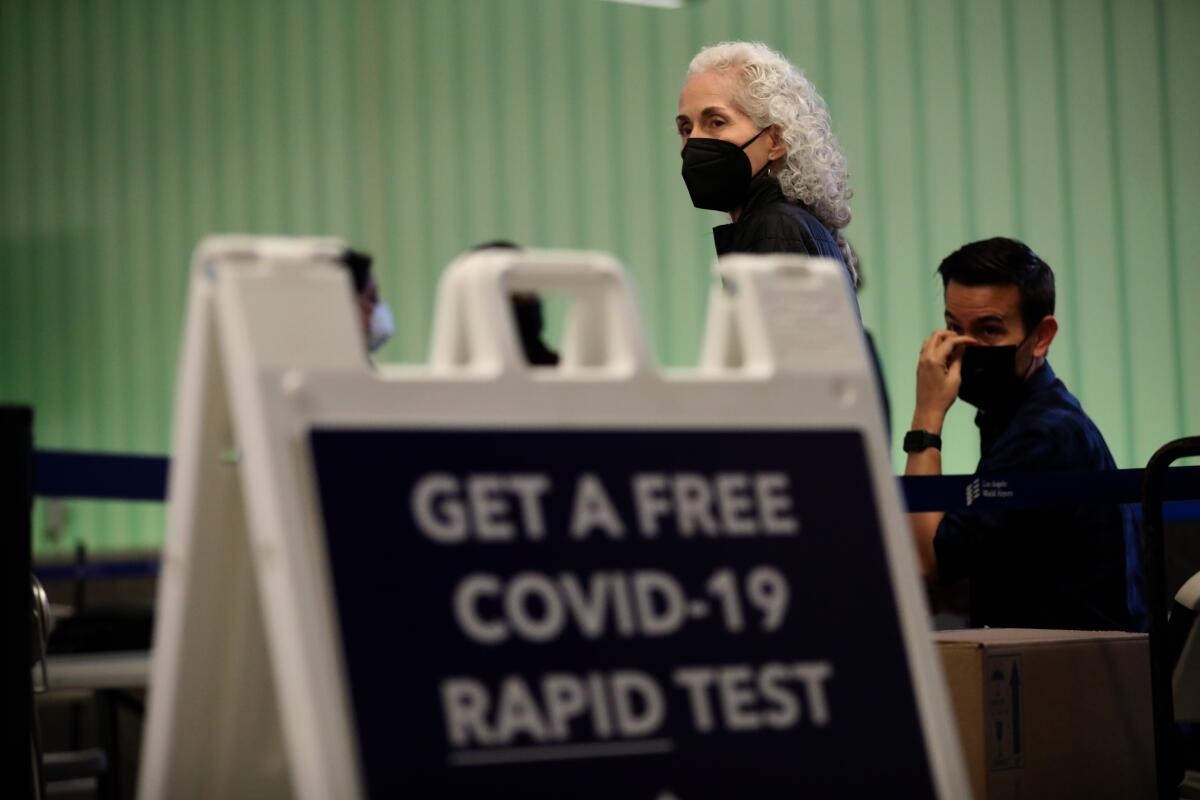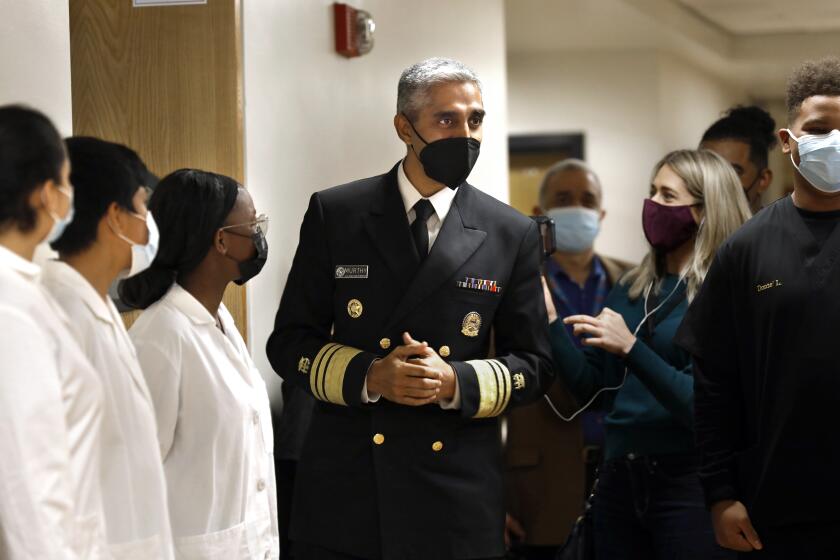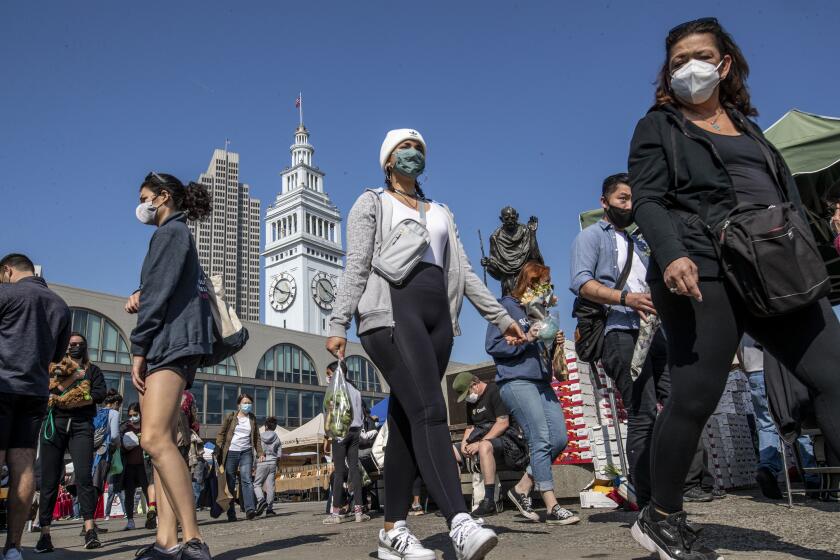California prepares for winter COVID-19 surge; if not from Omicron, then from Delta

California is preparing for a winter COVID-19 surge — if not from the newly identified Omicron variant, then from the Delta variant, which still poses a severe threat and has already caused surges in other states.
It’s still far from clear what kind of increase California will see, and the state has been doing better than other parts of the country. But officials say they want to be ready.
Surge planning is also well underway in Central California, which has recently experienced a reprieve in COVID-19 hospitalizations, falling by nearly 30% since mid-November.
Still, the San Joaquin Valley’s most populous county, Fresno, has a COVID-19 hospitalization rate more than triple that of Los Angeles County, and Fresno officials are expecting the winter surge will again be bad.
“An anticipated winter surge ... may strike in the next few weeks,” said Dr. Rais Vohra, the interim health officer for Fresno County. But unlike with last year, there are no plans for alternative care sites or cots at the convention center. “So if we have a surge, we’re really just left with what resources the hospitals are able to leverage just on their own campuses.”
If hospitals get extremely busy, they may be forced to implement crisis standards of care, Vohra said, potentially being required to ration healthcare to patients based on who is more likely to survive.
The advisory is to call attention to a “youth mental health crisis” and recommend resources to call on and actions to take.
“December is going to be a very critical month for us to watch the numbers,” Vohra said. “Because if we do get a winter surge, then I think it will show up within the month of December. And if it starts, then it may last throughout the winter months, because that’s exactly what happened last year.”
Nursing homes have become an area of focus in Los Angeles County. The county Department of Public of Health on Monday ordered that all skilled nursing facility residents, workers and contractors who might encounter residents must test for the coronavirus once a week, regardless of vaccination status, between Dec. 15 and Jan. 31.
Also, all visitors to such nursing homes will need to provide a recent negative coronavirus test before entry. Rapid test kits will be made available to the facilities. People who have recovered from a coronavirus infection within the last 90 days will not need to test weekly or show proof of a negative test to enter a nursing home.
It’s still too early to know for certain whether coronavirus case rates will rise across California as a result of gatherings over Thanksgiving. But officials in at least one county, San Diego, are suspecting that an uptick in locally reported cases late last week may be the initial sign of an increase in transmission related to Thanksgiving.
“Rises like these after holidays are not unexpected,” Dr. Cameron Kaiser, a San Diego County deputy public health officer, said in a statement.
“Thanksgiving just happened. People just had their gatherings. And sometimes it takes time for people to test,” said Dr. Regina Chinsio-Kwong, a deputy health officer for Orange County. “We may see a rise [in cases], and maybe we won’t. But it is important for all of us to take precaution, as we see other states see a rise in cases, and we want to protect our loved ones.”
Health officials suggested a multi-pronged strategy for a safer holiday — getting vaccinated and boosted, testing regularly and potentially scaling down holiday gatherings by limiting guests to those who are vaccinated, keeping them smaller, and taking steps to reduce risk, such as holding them outdoors.
For celebrations that are planned for December, “you may want to tone that down to small gatherings that are more safe,” Chinsio-Kwong said. “Hopefully, most guests are vaccinated and even then, really restrict how many people are going to gather ... or have the gathering outside.”
Concerns remain about how transmissible Omicron may be.
People should also consider testing more frequently, given the wide availability of coronavirus testing by healthcare providers as well as rapid tests that can be purchased at a pharmacy and taken anywhere, with results available in 15 minutes.
For instance, it makes sense for older people to ask guests — including those who are fully vaccinated and boosted — to screen themselves with a rapid test before they enter their home, Los Angeles County Public Health Director Barbara Ferrer said.
“We should be cautious — as cautious as we can be while we’re getting more information about Omicron. But I also want to note: Delta [is still] highly infectious,” Ferrer said.
While vaccinations lower the risk of infection and severe disease, it is still possible for fully vaccinated people to get infected and transmit the virus to other people.
“And when we travel, we need to be more careful. And we need to test, test, test,” Chinsio-Kwong said.
Coronavirus testing is free in California to anyone who needs it, and anyone should get tested if they feel any symptoms, regardless of vaccination status, the California Department of Public Health says. Free testing sites can be found at the state’s website, covid19.ca.gov/get-tested.
The Los Angeles County Department of Public Health has started to offer free rapid tests to incoming international passengers. On Wednesday, Orange County will begin offering free testing kits to incoming airline passengers at John Wayne Airport, where they can send their sample by FedEx to be analyzed. Orange County also allows residents and people who work there to request free tests online, which come with prepaid return shipping.
In Los Angeles, a coronavirus testing site has reopened at Dodger Stadium.
L.A. County requires residents who test positive for the coronavirus, or who a healthcare provider suspects have been infected, to go into isolation and inform close contacts that they have been exposed. People need to stay in their place of isolation except to receive necessary medical care.
People must isolate for at least 10 days since symptoms first appeared or, if they were not symptomatic, 10 days after the date of their first positive coronavirus test.
There are several signs of progress in the fight against COVID-19.
Health officials across California are reporting an uptick in interest in vaccinations, including among young children, as well as booster shots.
“I’m really happy to see that we did see a rise in demand for vaccines, at least following the Thanksgiving holiday,” Chinsio-Kwong said. Concerns about the spread of Omicron may have also contributed to people finally deciding to get their vaccination or their booster.
And some areas are now reporting ample supply and resources for newly infected people to get treated with monoclonal antibodies, a treatment for COVID-19 that can counteract the coronavirus before it can begin destroying the body’s organs. Monoclonal antibodies need to be administered at a medical facility through an intravenous infusion.
“At this point, our supply is actually exceeding the demand” in Fresno County, Vohra said. “While we were very worried early on that we didn’t have enough providers that were giving the monoclonal antibodies, right now, we have over a dozen clinics that are fully functional, operational with monoclonal antibodies.”
The National Institutes of Health says that monoclonal antibodies can be used to treat mild to moderate COVID-19 in nonhospitalized patients at high risk for progressing to severe disease. But the drugs work only if they’re administered early — it’s generally too late to get monoclonal antibodies once an infected person is struggling to breathe and is suffering from pneumonia, Vohra said.
For every 100,000 residents, Fresno County has 20 hospitalized patients with COVID-19, while Los Angeles County has 6 and Orange and Ventura counties have 5. The San Francisco Bay Area has a rate of 4.
Other counties in Southern California have higher hospitalization rates. San Diego County has a rate of 9; Riverside County, 10; and San Bernardino County, 16. Some experts say it’s a sign of concern when the rate is 5 or worse.
Most of California’s counties are reporting substantial or high coronavirus transmission, the worst two levels of the U.S. Centers for Disease Control and Prevention’s four-tier scale.
More to Read
Sign up for Essential California
The most important California stories and recommendations in your inbox every morning.
You may occasionally receive promotional content from the Los Angeles Times.














